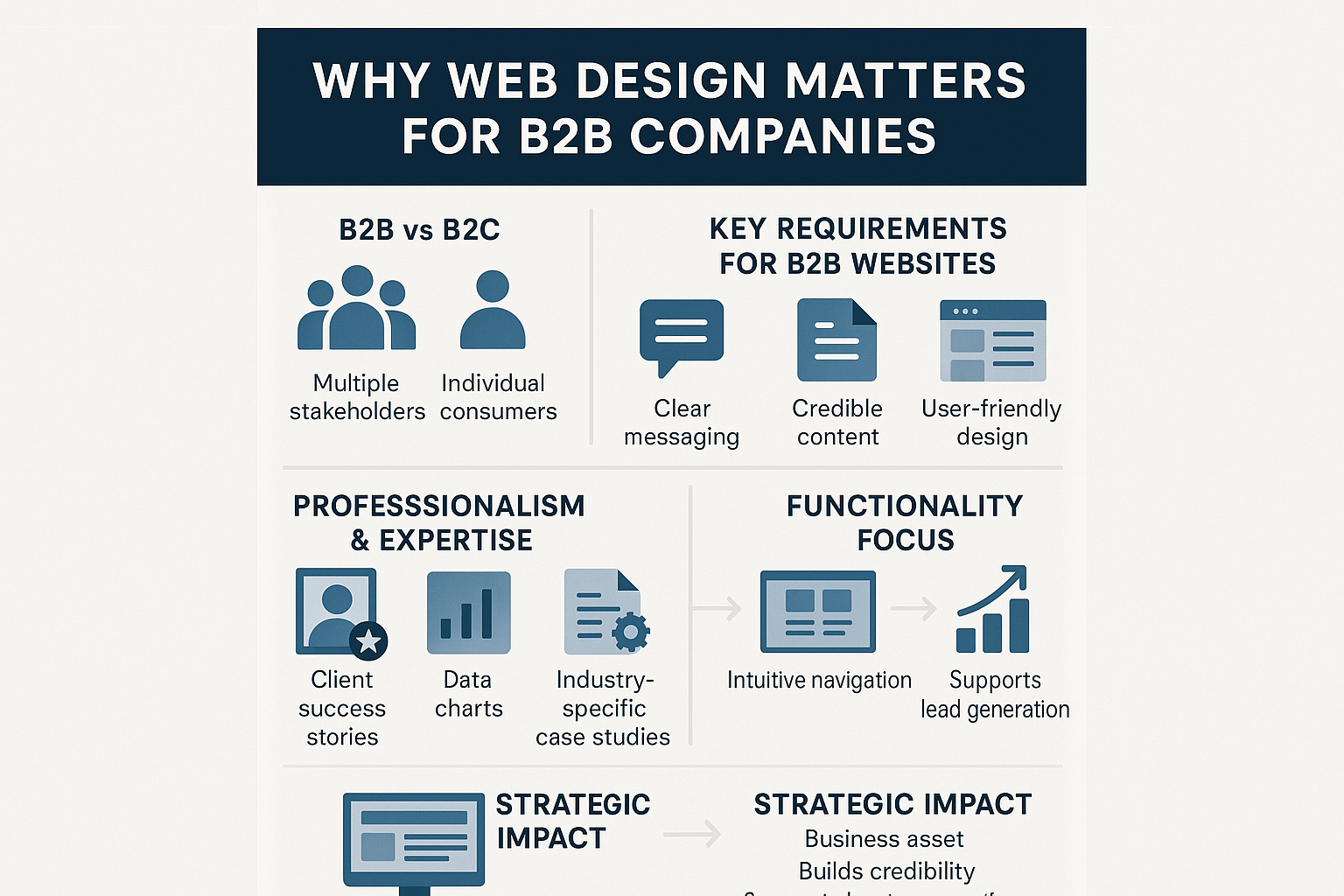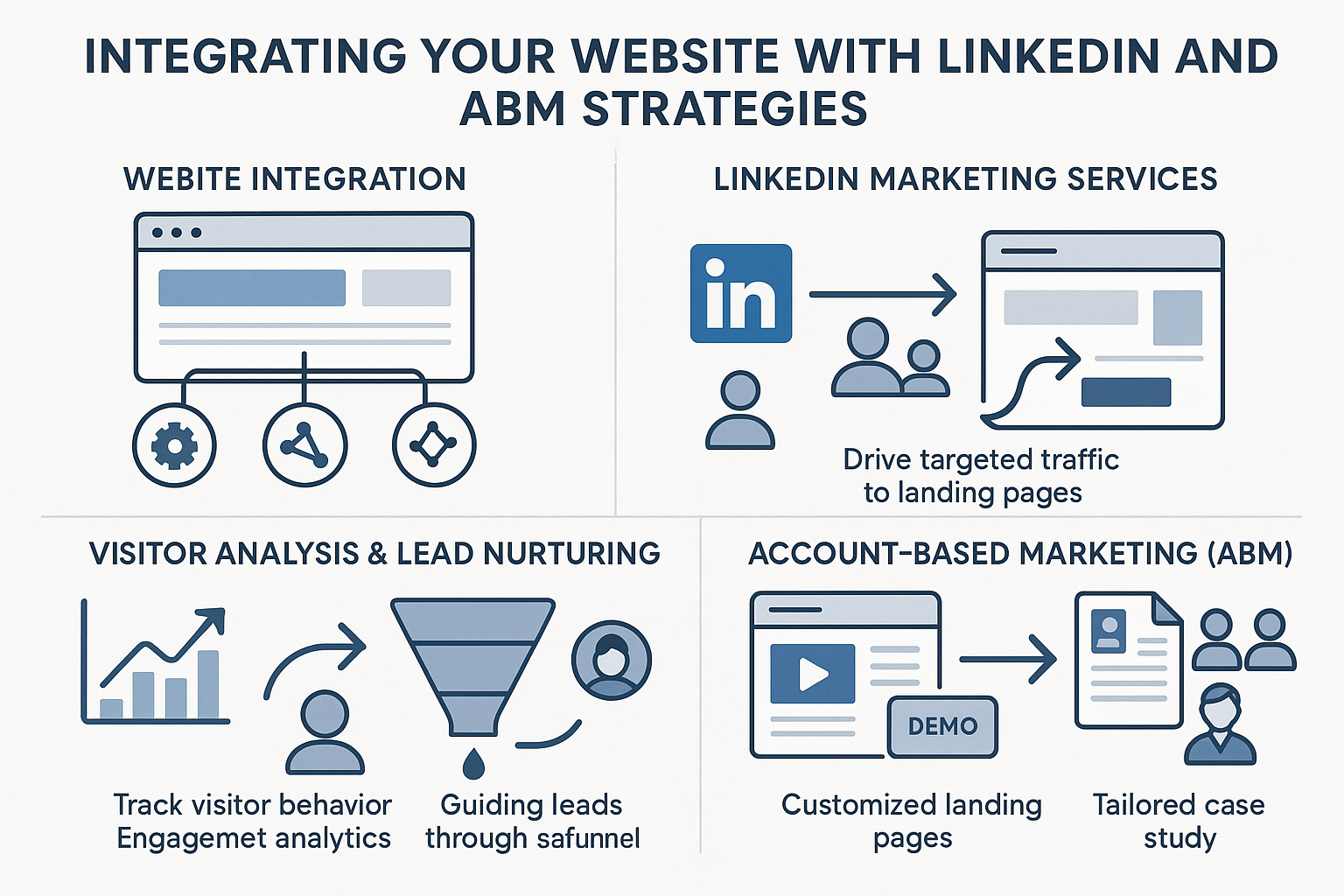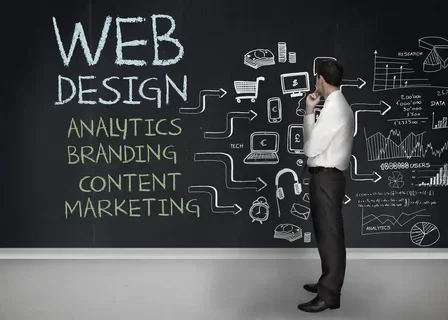In today’s highly competitive B2B sector, your website acts as the digital gateway to your business. Often, it’s the first point of interaction potential clients or partners have with your brand. A thoughtfully designed website does more than just look good; it captures attention, establishes credibility, and encourages conversions.
For businesses operating in sectors such as technology, professional services, manufacturing, or SaaS, an optimized B2B web design service is not just an aesthetic choice; it’s a strategic tool that can influence purchasing decisions, build trust, and enhance customer retention.
Every element, from layout and typography to calls to action (CTAs), plays a crucial role in guiding prospects along the buyer journey. Understanding the importance of web design for B2B companies ensures that the website not only reflects the brand but also drives performance.
In this blog, we’ll explore the key elements of web design for B2B companies, its impact on user engagement, and how it integrates with broader marketing strategies, including LinkedIn Marketing Services, account-based marketing, Email Marketing Services, and Content Marketing Services.
Why Web Design Matters for B2B Companies?
In the competitive B2B world, understanding what is B2B marketing and implementing an optimized website strategy is key. A B2B website differs from a B2C website, as it targets multiple stakeholders and decision-makers. While B2C platforms often target individual consumers and aim to evoke emotion, B2B websites must cater to multiple stakeholders and decision-makers.

This requires clear messaging, credible content, and a user-friendly design. A modern B2B website development ensures your business communicates professionalism, reliability, and expertise.
For instance, integrating client success stories, data-backed insights, or industry-specific case studies into your design provides the type of detailed information B2B buyers expect.
Beyond aesthetics, B2B web design services should focus on functionality, ensuring prospects can find the information they need quickly and easily.
Understanding what is the digital marketing strategy that tracks users across the web can help ensure that your website’s design includes tracking tools that optimize user engagement and inform design decisions, improving conversion rates. How do web design trends influence B2B buyer decisions? By aligning with user behavior trends, companies ensure their website is a powerful tool for engagement.
A website that successfully balances design and strategy acts as a business asset, not just a marketing tool. It positions your company as a credible industry leader while supporting lead generation and conversion optimization efforts.
1. First Impressions Are Everything
In the B2B world, first impressions can significantly influence buyer behavior. A poorly designed website can create doubt about your company’s professionalism, while a B2B web designer ensures that the first encounter builds trust.
Visual hierarchy, professional color palettes, and well-organized content enhance credibility. Interactive elements such as live demos, video testimonials, or dynamic case studies add value and reinforce expertise.
In fact, research shows that users form an opinion about a website within 0.05 seconds, highlighting the need for an immediate and positive visual impact. The impact of good web design on B2B marketing strategies is crucial, as B2B companies need a more formal, data-driven approach, while B2C may lean more on emotional appeal.
By investing in a B2B website design that prioritizes both aesthetics and usability, businesses can maximize engagement, retain visitor attention, and encourage meaningful interactions with their brand.
2. Building Trust and Credibility with Effective Design
Trust is the cornerstone of all B2B relationships. Leveraging web design and SEO marketing for B2B success, a B2B web design service that integrates elements like client testimonials, certifications, awards, and case studies provides the social proof needed to reassure potential clients.
Additionally, transparency in content and clear navigation can significantly enhance credibility. For example, placing product specifications, pricing structures, and process overviews prominently on relevant pages builds confidence in your offerings.
Understanding the importance of web design for B2B companies helps ensure these key elements are strategically placed to maximize trust.
When combined with professional visuals and thoughtful UX, these features make your website a key tool in long-term relationship-building and conversion optimization.
When combined with professional visuals and thoughtful UX, these features make your website a key tool in long-term relationship-building and conversion optimization.
3. User Experience (UX) and Navigation
User experience (UX) is a major determinant of whether a website converts visitors into leads. An intuitive navigation system, clean content structure, and visible CTAs guide users through the sales funnel seamlessly. Website design and development for B2B companies must prioritize functionality, ensuring prospects can find the information they need quickly and easily.
Effective B2B web development ensures that content flows logically, from problem identification to solution explanation to conversion-focused calls to action. Why B2B firms need web marketing graphic designers is evident in the way well-designed visuals support seamless user journeys.
Integrating Content Marketing Services, such as blogs, whitepapers, and video tutorials within the website, not only enhances SEO but also educates prospects and nurtures them toward decision-making.
Businesses that invest in UX-focused B2B web design see measurable improvements in session duration, reduced bounce rates, and increased conversions. How can redesigning a website drive business growth for B2B companies? A website redesign tailored to your audience's needs enhances user experience, boosting engagement and conversion rates.
4. Mobile Optimization for a Seamless Experience
With more decision-makers accessing information on mobile devices, mobile optimization is no longer optional. Responsive design ensures that websites look and function flawlessly on smartphones, tablets, and desktops alike.
A B2B website design optimized for mobile includes features such as collapsible menus, mobile-friendly forms, and fast-loading visuals.
By offering a consistent experience across devices, businesses increase engagement, reduce frustration, and boost the likelihood of lead generation and conversion. What is the value of responsive design for B2B companies? It ensures your website is accessible to all users, no matter the device, driving higher engagement.
5. SEO and Web Design Integration
A well-designed website plays a crucial role in achieving SEO success. Web design B2B and SEO must go hand-in-hand, from clean site architecture and optimized headings to fast loading times and responsive layouts.
Integration of Creative Services further strengthens SEO performance. High-quality blogs, video content, and downloadable resources increase dwell time, drive inbound links, and improve keyword rankings, ultimately making your website a top-performing lead generation asset. Why should B2B organizations invest in professional website development? To enhance SEO and drive qualified traffic.
Understanding what is network marketing and its relationship with SEO can be helpful for B2B companies. Both rely on building strong networks and reaching out to highly targeted groups, whether it's for lead generation or building authority online.
6. Conversion Rate Optimization (CRO)
A B2B website should not just inform,it must convert. Conversion rate optimization includes designing landing pages that drive specific actions, placing strategically timed CTAs, and analyzing user behavior to improve engagement.
Integrating Email Marketing Services ensures that leads nurtured via automated campaigns are directed to landing pages designed for conversion. Personalized email links to relevant content, product pages, or demos can significantly enhance conversion rates.
By providing personalized email links to relevant content, product pages, or demos, businesses can significantly improve their conversion rates. What are the benefits of personalized web development for B2B firms? It allows for customized user journeys, improving engagement and conversions.
7. Continuous Monitoring and Improvement
A website is never truly finished. Continuous monitoring using tools like Google Analytics, heatmaps, and user feedback helps identify areas for improvement.
Regular updates, such as refreshing content, optimizing UX, and implementing new technical features, ensure the site remains aligned with market trends and evolving buyer expectations.
Combining these updates with LinkedIn Marketing Services or account-based marketing campaigns enhances the website’s role as a central hub for lead generation and engagement.
8. Integrating Your Website with LinkedIn and ABM Strategies
A website works best when integrated with broader marketing strategies. LinkedIn Marketing Services allow B2B businesses to drive highly targeted traffic to campaign-specific landing pages.
By analyzing visitor behavior and engagement, companies can nurture leads effectively throughout the sales funnel.
Account-based marketing takes this further by providing personalized experiences for high-value accounts. Customized landing pages, interactive demos, and tailored case studies ensure decision-makers see content that speaks directly to their needs, improving conversion rates and ROI.
Explore Our LinkedIn Marketing Services!
9. Enhancing Engagement with Email and Content Marketing
Pairing Email Marketing Services with your website ensures that automated sequences, newsletters, and lead nurturing campaigns direct users back to relevant pages. This creates a seamless experience and drives action.
Combining this with creative marketing services, such as whitepapers, blogs, videos, and interactive tools, strengthens SEO, builds authority, and educates prospects.
This integrated approach transforms your website from a static presence into a proactive lead generation platform, improving engagement, nurturing prospects, and delivering measurable business results.
Explore Our Email Marketing Services!
10. Leveraging Analytics to Optimize Your Website Performance
Data-driven decision-making is crucial for maximizing the impact of your B2B web design services.
By leveraging analytics tools like Google Analytics, heatmaps, and CRM integrations, businesses can monitor user behavior, track conversion paths, and identify potential friction points on the website.
Insights gained from analytics allow companies to refine navigation, adjust content placement, and improve CTAs for higher engagement and conversions.
Integrating analytics with Email Marketing Services and LinkedIn Marketing Services campaigns ensures that marketing efforts are measurable, enabling continuous optimization of landing pages and content.
To further enhance your website’s performance, consider what are five marketing strategies that retailers spend half of their annual budget on? This can guide you in ensuring your website aligns with marketing priorities that generate long-term results.
This feedback loop not only enhances user experience but also drives sustainable ROI by identifying the tactics that resonate most with your target audience.
11. Personalizing Experiences with Account-Based Marketing
Personalization is a game-changer in the B2B landscape, and account based marketing strategies make this possible.
By tailoring website experiences for specific high-value accounts, businesses can provide relevant content, product recommendations, and case studies that speak directly to the prospect’s needs.
Implementing ABM on your website might include dynamic landing pages, customized offers, and interactive product demos that adapt to the visitor’s company profile or industry.
When combined with creative marketing services, these strategies ensure that prospects feel seen and understood, improving engagement, trust, and conversion rates.
These strategies ensure prospects feel understood, which improves engagement and conversion rates. Using best SEO reporting tools can help track the effectiveness of these personalized strategies and measure their ROI accurately.
Explore Our Account Based Marketing Services!
12. Strengthening Lead Nurturing through Multi-Channel Integration
A B2B website becomes a powerful lead-nurturing platform when integrated across multiple channels.
Coordinating Email Marketing Services, LinkedIn Marketing Services, and Content Marketing Services ensures that prospects are consistently guided along the sales funnel, from initial awareness to final decision-making.
For example, a lead might engage with a blog post hosted on your website, receive a personalized email with additional resources, and then encounter targeted LinkedIn ads that reinforce your value proposition.
This multi-channel approach not only increases engagement but also builds authority and trust, creating a seamless and persuasive journey that drives conversions for B2B businesses.
Key Web Design Principles to Enhance B2B Success
Effective web design is crucial for B2B companies looking to build trust and drive conversions. The following key principles will help optimize your website to attract, engage, and convert high-value business clients.
| Principle | What You’ll Get | Why It Matters in B2B | Quick Implementation Tip |
|---|---|---|---|
| First Impressions & Visual Credibility | A website that feels professional and trustworthy at first glance. | In B2B, decision‑makers judge credibility quickly; a poor first impression can kill trust. | Use a clean layout, professional colour palette, high‑quality imagery of your solutions/case‑studies. |
| Trust & Social Proof | Increased confidence from prospective clients and shorter decision cycles. | B2B buyers seek proof (certifications, testimonials, case studies) before engaging. | Add client logos, quotes from satisfied clients, and case‑study links near key pages. |
| User Experience (UX) & Navigation | Visitors stay longer, explore more, and convert better. | B2B buyers often go through multiple pages and stakeholders; poor UX leads to drop‑offs. | Organise content by buyer‑journey stage (Problem → Solution → Proof → CTA), simplify menus, and reduce dead‑ends. |
| Mobile Optimization | Consistent experience across devices, capturing on‑the‑go decision makers. | Executives and stakeholders often browse on tablets/phones; a clunky mobile site hurts engagement. | Ensure responsive design, test forms/mobile input flows, and optimise images and menus for mobile. |
| SEO & Web Design Integration | Better visibility in search, more relevant organic traffic. | B2B purchase journeys often start with search; design affects site‑structure, speed, and headings. | Use semantic headings, fast page‑loads, clear URLs, mobile‑friendly design, and integrate your “SEO audit tools” and “SEO ranking report software” strategies. |
| Conversion Rate Optimization (CRO) | A higher percentage of site visitors become leads or contacts. | B2B leads are fewer but of high value; maximizing conversion efficiency is critical. | Place clear Call‑To‑Action (CTA) buttons, design landing pages around one goal, and run A/B tests. |
| Analytics & Continuous Improvement | Insights into what’s working, where prospects drop off, and how to fix it. | B2B sales cycles are long; data‑driven design tweaks improve pipeline and ROI. | Set up Google Analytics, heat‑map tools, integrate with CRM, review monthly, and iterate. |
| Personalization & ABM Integration | Tailored experience for high‑value accounts, increasing relevance and conversion. | B2B firms often run account‑based marketing (ABM); the website must reflect that high‑touch approach. | Use dynamic landing pages, industry‑specific case studies, and personalised content based on visitor profile. |
| Multi‑Channel Integration | The website becomes a central hub for Email, LinkedIn, Content Marketing, and other efforts. | B2B marketing spans multiple channels; a unified experience strengthens the message and the nurture process. | Ensure consistent branding and messaging across your website, email campaigns, and LinkedIn landing pages. |
FAQs: Importance of Web Design for B2B Companies
How does web design impact B2B lead generation?
A well-designed website B2B serves as a lead generation tool by offering intuitive navigation, engaging content, and conversion-focused elements. Understanding the importance of web design for B2B companies allows you to optimize these features to drive potential clients through the sales funnel.
What role does mobile optimization play in B2B web design?
Mobile-friendly B2B web design services ensure seamless browsing across devices, enhancing engagement and conversion potential.
How can SEO be integrated into web design?
SEO can be integrated through fast-loading pages, optimized headings, meta tags, alt texts, and mobile responsiveness.
Why is UX important in B2B web design?
Good UX ensures that visitors can easily navigate the site, interact with content, and complete desired actions, boosting trust and conversions.
How do LinkedIn, ABM, Email, and Content Marketing support web design?
Integrating LinkedIn Marketing Services, account-based marketing, Email Marketing Services, and Content Marketing Services drives traffic, nurtures leads, and improves ROI.
The Final Verdict
A strategically designed website for B2B companies strengthens credibility, enhances SEO, drives conversions, and can seamlessly integrate with broader marketing strategies such as LinkedIn Marketing Services, account-based marketing, Email Marketing Services, and Content Marketing Services. A well-executed B2B website development project ensures that your business not only attracts potential clients but also engages them meaningfully throughout their buyer journey. Investing in professional web design for B2B companies guarantees that your site is visually appealing, technically robust, and optimized for both user experience and search engines. It transforms your website from a static online presence into a dynamic lead-generating platform that supports sustainable growth.
Beyond aesthetics, strategic B2B web design focuses on intuitive navigation, responsive layouts, fast loading times, and compelling calls-to-action that encourage visitors to take meaningful steps, whether that’s requesting a demo, downloading resources, or contacting your team. Ultimately, the importance of web design for B2B companies lies in its ability to reflect your brand’s credibility, differentiate your business in competitive markets, and create measurable outcomes that support long-term success. By aligning your website with broader marketing initiatives, your business can deliver a consistent, cohesive, and engaging experience to both prospects and clients. At Centric, we specialize in designing and developing B2B websites that are not only visually striking but also strategically built to achieve tangible results, helping companies grow, connect, and thrive in today’s competitive digital landscape.








